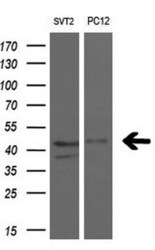Antibody data
- Antibody Data
- Antigen structure
- References [0]
- Comments [0]
- Validations
- Western blot [2]
- Immunocytochemistry [1]
- Flow cytometry [1]
Submit
Validation data
Reference
Comment
Report error
- Product number
- CF503550 - Provider product page

- Provider
- Invitrogen Antibodies
- Product name
- RAD51L1 Monoclonal Antibody (OTI7H4), TrueMAB™
- Antibody type
- Monoclonal
- Antigen
- Recombinant protein fragment
- Reactivity
- Human
- Host
- Mouse
- Isotype
- IgG
- Antibody clone number
- OTI7H4
- Vial size
- 100 µg
- Concentration
- 1 mg/mL
- Storage
- -20° C, Avoid Freeze/Thaw Cycles
No comments: Submit comment
Supportive validation
- Submitted by
- Invitrogen Antibodies (provider)
- Main image

- Experimental details
- HEK293T cells were transfected with the pCMV6-ENTRY control (Left lane) or pCMV6-ENTRY RAD51L1 (RC206457, Right lane) cDNA for 48 hrs and lysed. Equivalent amounts of cell lysates (5 µg per lane) were separated by SDS-PAGE and immunoblotted with anti-RAD5. Positive lysates LY408768 (100 µg) and LC408768 (20 µg) can be purchased separately from OriGene.
- Submitted by
- Invitrogen Antibodies (provider)
- Main image

- Experimental details
- Western blot analysis of extracts (10 µg) from 2 different cell lines by using anti-RAD51L1 monoclonal antibody at 1:200 dilution.
Supportive validation
- Submitted by
- Invitrogen Antibodies (provider)
- Main image

- Experimental details
- Anti-RAD51L1 mouse monoclonal antibody (TA503550) Immunofluorescent staining of COS7 cells transiently transfected by pCMV6-ENTRY RAD51L1(RC206457).
Supportive validation
- Submitted by
- Invitrogen Antibodies (provider)
- Main image

- Experimental details
- HEK293T cells transfected with either RC206457 overexpress plasmid (Red) or empty vector control plasmid (Blue) were immunostained by anti-RAD51L1 antibody (TA503550), and then analyzed by flow cytometry.
 Explore
Explore Validate
Validate Learn
Learn Western blot
Western blot